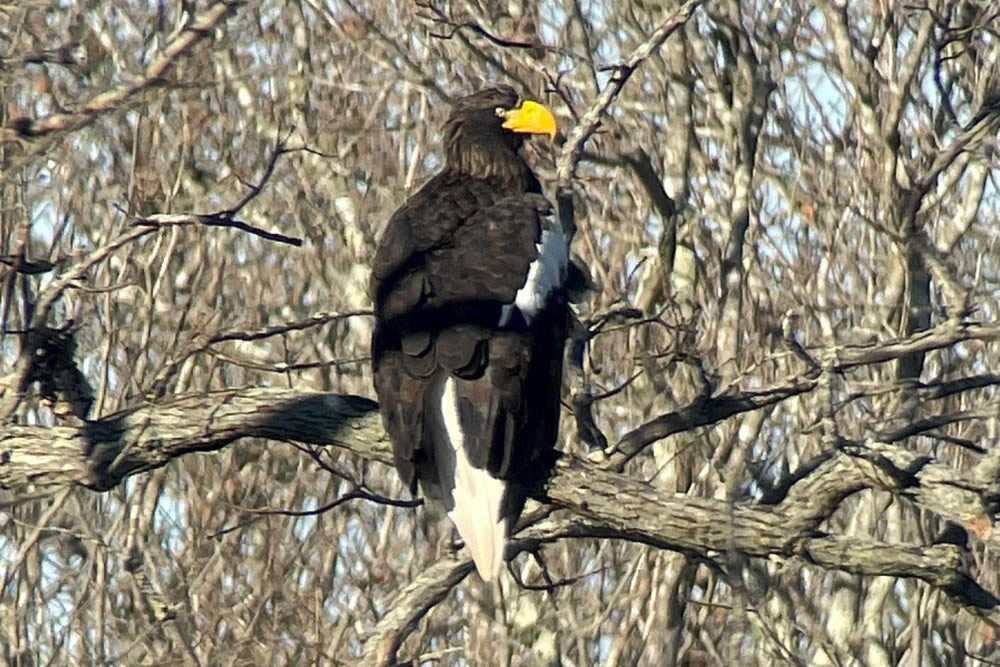
A couple of months ago, our article featured “Eagles Over Houston”, spotlighting the majestic American Bald Eagle (Haliaeetus leucocephalus). They are unquestioningly majestic creatures, with their distinctive white head and bright yellow beak, and large size. They make quite the sight soaring above our heads in search of prey. But did you know that recently, there has been another type of raptor sighted at various locations throughout North America that almost dwarfs our national symbol? Not only that, it shouldn’t even be here, since it’s from a different continent entirely!
Meet the Steller’s Sea-eagle (Haliaeetus pelagicus), a bird that has lately been taking the birding community by storm. One particular individual has been spotlighted in the news and on social media for over a year, a visitor from northeast Asia that has somehow found itself wandering from Alaska, to northeast Canada, and even down into Maine and Massachusetts! Due to certain unique markings, it is believed that it is indeed just one individual doing all of this traveling.
Steller’s Sea-eagles have a mostly brown body, with white wing tips and tails, and a very large yellow beak. On average, they have a wingspan that, at eight feet, is over a foot longer than the bald eagle’s. They can also weigh anywhere from 13 to 20 pounds, up to twice the size of its smaller cousin. They are native to northeast Asia – specifically northeast Russia – and during warmer months will migrate to Japan and North Korea. Their habitat lies along coastlines and rivers where they feast mostly on fish and ducks (salmon being a particular favorite). They prefer an environment with tall trees so they can perch and survey their surroundings in search of food.
In their native habitat, Steller’s eagles are listed as vulnerable. There are only about 4,000 of these individuals in the wild, compared to hundreds of thousands of bald eagles. Habitat loss and climate change are the primary culprits, as well as lead poisoning and nesting predation by brown bears.
As stated earlier, one of these unique critters has been sighted several times on our continent of North America, beginning with a sighting in Alaska back in August of 2020, along the Denali Highway. This really isn’t too surprising, given that Alaska isn’t that far from Russia, relatively speaking. It wouldn’t be too difficult to traverse the Bering Strait into our territory. But it is the subsequent sightings, thousands of miles away, that makes this tale even more extraordinary.
Amazingly, a Steller’s Sea-eagle was spotted in Victoria, Texas – Texas!! – in March of 2021. This was during the harsh spring freeze of that year, so perhaps the bird followed the cold front south into uncharted territory. Although it’s impossible to know for sure if it was the same bird that was seen in Alaska, the likelihood is pretty high, given the extreme rarity of the bird on this continent.
The next reported sighting, on June 28 of 2021, was in New Brunswick, Canada – 2,500 miles from the Texas sighting, and 4500 miles from the Alaska sighting. This was when interest really started to heat up, with people converging on the location from all over Canada. Comparison of feather markings on the wings confirmed that this was indeed the same bird that had been seen in Alaska almost a year earlier. After wandering around the area for about a month, it flew off everyone’s radar until November 3, when it showed up in Nova Scotia for two days before disappearing again.
Then, starting in mid-December 2021 and throughout the month of January 2022, the US birding community was treated to this rare phenomenon when the bird was seen first in Massachusetts, and then in Maine. And Maine is where it seems to be staying, at least for now.
These rare sightings of an Asian eagle in North America are an example of the phenomenon known as vagrancy. It’s a rare but regular occurrence among certain bird species. There are several possible reasons why birds wander so far from their home range. Juveniles especially like to take off on their own in search of new territory. Habitat loss and changing weather patterns, including extreme weather events, can be contributing factors. And sometimes, birds just lose their sense of direction and migrate toward a wrong turn!
The Steller’s eagle may not be from around here, but that doesn’t mean it can’t teach us something. The arrival of this lost, wandering vagrant on American soil has not only brought some unexpectedly delightful viewing opportunities; It has also afforded us a glimpse into its plight, and an awareness of why it’s so important to protect our most vulnerable species. Most American and Canadian birders wouldn’t have even known this species exists if this individual hadn’t turned up on our shores! Keep your eyes peeled. You might not see a Steller’s eagle, but who knows what other rare and wondrous gems you might see, if you only pay attention.


